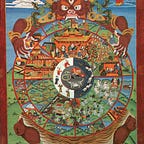Preparing For The Lama (Oct. 22)
About a week after my conversation with Chodak by the road side food stalls, I was at home in my study reading the collaborative work of Lama Kazi Dawa-Samdup and W.Y. Evan-Wentz’s “The Tibetan Book of the Dead”[1], as it’s most commonly known, when I heard a loud steady banging at my front door. I looked at my watch and saw that it was eight o’clock in the morning. I wondered who it was with such urgency at my front door. Begrudgingly, I got up from my chair and made my way to the front door.
As I got close to the door I heard a soft whisper, “Tenzin…”, immediately I realized that it was Chodak. I opened the door and was met with the glowing face of a young man eager to tell me some astonishing news. “Chodak”, I said, “have you been smoking the opium the farmers are growing in the village? What makes you destroy my solitude this early in the morning?”. “The arrival of a great teacher destroys many from their quiet solitude”, he said. “So”, I said, “your great teacher is coming to the village after all?”. “Yes”, he exclaimed, “You must donate now what you promised you would back at the food stall”. Jokingly I said, “I don’t recall making a promise Chodak”. The boy was not amused. “Anyways”, I said, “run along now I must get ready to go to my workshop. I’ll donate what I can on the way there to the monks and nuns”. With that, my young companion set off and I set off to go shower and get ready for the day.
Once I was ready to go, I noticed a strange smell in the air as I closed my front door. I looked off into the distance and noticed that some of the villagers were taking part in an elaborate funeral procession. I was reminded of the mortuary practices described by Sanggye Gyatso, the fifth Dalai Lama’s regent, for the twelve different classes and occupations[2]. In this document, cremation was the most prevalent way of sending the departed to re-birth. The intermediate stage between death and rebirth is known as the bardo[3]. It’s the escape from the realm of the bardo that is the foundational belief behind cremation. The dead person must have no attachment to their former life and must embrace their inevitable re-birth whether in the higher or lower realms. Pondering these thoughts, I made my way over to the local monastery to donate some of my wealth for the arrival of the lama.
When I arrived at the monastery, I was glad to see both monks and nuns going about their business. For some reason though, I found myself showing slight signs of reverence and respect towards the nuns more than I did the monks. For example, when a group of nuns passed by me as I made my way into the monastery I lowered my gaze and my head. This could be because I subconsciously was acknowledging the fact that they had stricter precepts than monks in order to call themselves Bhikkhunis (nuns). In that sense, I believed them to be in a class higher than the Bhikkhus (monks). Anyways, I made my offering of wealth to a grizzly looking Bhikkhu and made my way to my workshop thinking that I could no longer be bothered by Chodak to help with the lama’s visit.
I arrived at my workshop to find that business was indeed booming. It seems that the arrival of the lama has caused the village people to require many tools to build their various offerings. I checked in with my foreman Wangdue to see how things were going. “Wangdue”, I called out, “do we have enough supplies to make the tools these people require?”. “We are running low on iron for axe heads”, he said. “I’ll send word to our supplier at the nearby village”, I responded. With that, I set out quickly to a nearby border village where my supplier for iron was located. I mounted my horse and began the trek which would take usually two hours through the rocky and treacherous terrain. On my way over, I thought about the doctors, nuns, and ritualists who made a similar trek in order to help the village plagued by the Naga illness. I heard from Wangdue that many people lost their lives during this trek. With these thoughts running through my mind I slowly made my way up the cold snow capped mountains thinking of the ominous journey ahead of me.
[1] Lama Kazi Dawa-Samdup, The Tibetan Book of the Dead, complied and edited by W.Y. Evans-Wentz (London: Oxford University Press, 2000).
[2] Edited by Kurtis R. Schaeffer, Matthew T. Kapstein, and Gray Tuttle, Sources of Tibetan Tradition (New York: Columbia University Press, 2013), pg. 465.
[3] Edited by Kurtis R. Schaeffer, Matthew T. Kapstein, and Gray Tuttle, Sources of Tibetan Tradition (New York: Columbia University Press, 2013), pg. 449.
Bibliography
1.) Edited by Kurtis R. Schaeffer, Matthew T. Kapstein, and Gray Tuttle, Sources of Tibetan Tradition, New York: Columbia University Press, 2013.
2.) Lama Kazi Dawa-Samdup, The Tibetan Book of the Dead, complied and edited by W.Y. Evans-Wentz, London: Oxford University Press, 2000.
3.) Image URL: http://apsorescuecolorado.wordpress.com/category/breed-history/
